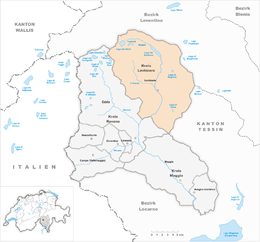Lavizzara
| Lavizzara | ||
|---|---|---|

Fusio village
|
||
|
||
| Coordinates: 46°26′N 8°39′E / 46.433°N 8.650°ECoordinates: 46°26′N 8°39′E / 46.433°N 8.650°E | ||
| Country | Switzerland | |
| Canton | Ticino | |
| District | Vallemaggia | |
| Government | ||
| • Mayor | Sindaco | |
| Area | ||
| • Total | 187.5 km2 (72.4 sq mi) | |
| Elevation | 763 m (2,503 ft) | |
| Population (Dec 2015) | ||
| • Total | 540 | |
| • Density | 2.9/km2 (7.5/sq mi) | |
| Postal code | 6692-6696 | |
| SFOS number | 5323 | |
| Localities | Broglio, Brontallo, Fusio, Menzonio, Mogno, Monti di Rima, Peccia, Piano di Peccia, Prato, San Carlo, Sant'Antonio, Sornico | |
| Surrounded by | Airolo, Bedretto, Brione (Verzasca), Cevio, Chironico, Dalpe, Maggia, Prato Leventina, Quinto, Sonogno | |
| Website |
www SFSO statistics |
|
Lavizzara is a municipality in the district of Vallemaggia in the canton of Ticino in Switzerland.
The municipality was created in 2004 by a merger of Broglio, Brontallo, Fusio, Menzonio, Peccia and Prato-Sornico.
Broglio is first mentioned in 1361 as Brono. Brontallo is first mentioned in 1574 as Bruntalo. Fusio is first mentioned in 1258 as Fuxio. Menzonio is first mentioned in 1364 as Menzone. Peccia is first mentioned in 1374 as Petia. Prato and Sornico were first mentioned in 1374.
The existing village area has developed in several stages. It was created in 1374, when the valley (comunità) Lavizzara broke up and divided its lands. At the end of the 16th Century it grew again through a series of agreements between the neighboring communities.
The Church of S. Maria Lauretana was dedicated in 1487. In the following centuries, it was repeatedly rebuilt and restored. It belonged to the Sornico parish until 1616, when it became an independent parish. The historically significant building, Casa Pometta, is from the 17th Century.
The highest population in the village was during the 17th Century. The slow population decline intensified in the late 19th Century with emigration to the cities and to other countries. In 1990, agriculture and livestock, which for centuries were the main sources of income, employed about a third of the workforce. In recent decades, the number of vacation homes has increased markedly.
Until the beginning of the 15th Century it formed a community with Menzonio and together with Bignasco and Cavergno it formed a Vicinanza.
The church of S. Maria e S. Giorgio was first mentioned in the 15th Century. In the 16th Century it was rebuilt, and then renovated several times thereafter. Until 1513 it, along with Menzonio, was part of the parish of Cevio. In 1513 Menzonio broke away from Cevio, but Brontallo remained part of the parish until 1655.
The greatest population was during the 17th Century. The population decline began in the 18th Century, but accelerated into the 20th Century. The road running from the village into the Val Lavizzara was completed in 1955. In 1990 less than a third of the workforce was employed in agriculture. Many of the homes in the village are now vacation homes.
...
Wikipedia



